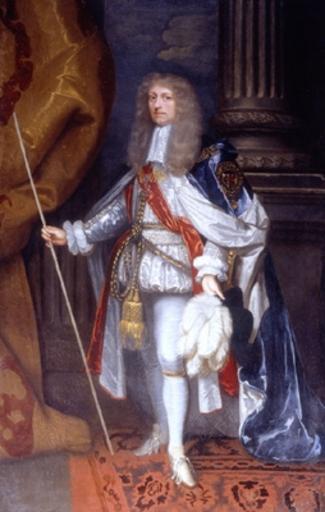MAKE A MEME
View Large Image

| View Original: | James_Butler,_1st_Duke_of_Ormonde.jpg (254x400) | |||
| Download: | Original | Medium | Small | Thumb |
| Courtesy of: | www.flickr.com | More Like This | ||
| Keywords: indoor James Butler, 1st Duke of Ormonde PC (19 October 1610 – 21 July 1688), was an Anglo-Irish statesman and soldier. He was the top commander of the Royalist forces in Ireland from 1641 to 1647 fighting against the Irish Catholic Confederation. From 1649 to 1650 he was top commander of the Royalist forces fighting against the Cromwellian conquest of Ireland. In the 1650s he lived in exile in Europe with Charles II of England. Upon the restoration of Charles II to the British throne in 1660, Ormonde became a major figure in English and Irish politics, holding many high government offices. James Butler was the eldest son of Thomas Butler, Viscount Thurles, and of Elizabeth, daughter of Sir John Poyntz, and the grandson of Walter, 11th Earl of Ormonde. The Butlers of Ormonde were an Old English dynasty who had dominated the southeast of Ireland since the Middle Ages. He was born in London. On the death of his father by drowning in 1619, the boy was made a royal ward by James I, removed from his Roman Catholic tutor, and placed in the household of George Abbot, archbishop of Canterbury, with whom he stayed until 1625, when he went to live in Ireland with his grandfather. This was very important for Butler's future life, as it meant that, unlike almost all his relatives in the Ormonde dynasty, he was a Protestant. This made his relationship with the rest of his family and dependents somewhat strained, as they suffered from land confiscations and legal discrimination on account of their religion, while he did not. In December 1629, he married his cousin, Lady Elizabeth Preston, daughter and heiress of Richard, Earl of Desmond, putting an end to the long-standing quarrel between the families and united their estates. In 1634, on the death of his grandfather, he succeeded to the earldom. With his wife, Elizabeth, he had at least 7 children, of whom three of his sons survived into adulthood. * Thomas Butler (1632 – 1632) * Thomas Butler, Earl of Ossory (1634 – 1680) * James Butler (1636 – 1645) * Richard Butler, 1st Earl of Arran (1639 – 1686) * Elizabeth Butler (b. 1640) * John Butler, 1st Earl of Gowran (1643 – 1677) * Mary Butler (1646 – 1710) The eldest of these, Thomas, Earl of Ossory (1634 – 1680) predeceased him, his eldest son (that is to say James Butler's grandchild) succeeded as 2nd Duke of Ormonde (1665 – 1745). The other two sons, Richard, created earl of Arran, and John, created earl of Gowran, both died without male issue, and the male descent of the 1st Duke becoming extinct in the person of Charles, 3rd Duke of Ormonde, the earldom subsequently reverted to the cadet descendants of Walter, 11th earl of Ormonde. James Butler, 1st Duke of Ormonde PC (19 October 1610 – 21 July 1688), was an Anglo-Irish statesman and soldier. He was the top commander of the Royalist forces in Ireland from 1641 to 1647 fighting against the Irish Catholic Confederation. From 1649 to 1650 he was top commander of the Royalist forces fighting against the Cromwellian conquest of Ireland. In the 1650s he lived in exile in Europe with Charles II of England. Upon the restoration of Charles II to the British throne in 1660, Ormonde became a major figure in English and Irish politics, holding many high government offices. James Butler was the eldest son of Thomas Butler, Viscount Thurles, and of Elizabeth, daughter of Sir John Poyntz, and the grandson of Walter, 11th Earl of Ormonde. The Butlers of Ormonde were an Old English dynasty who had dominated the southeast of Ireland since the Middle Ages. He was born in London. On the death of his father by drowning in 1619, the boy was made a royal ward by James I, removed from his Roman Catholic tutor, and placed in the household of George Abbot, archbishop of Canterbury, with whom he stayed until 1625, when he went to live in Ireland with his grandfather. This was very important for Butler's future life, as it meant that, unlike almost all his relatives in the Ormonde dynasty, he was a Protestant. This made his relationship with the rest of his family and dependents somewhat strained, as they suffered from land confiscations and legal discrimination on account of their religion, while he did not. In December 1629, he married his cousin, Lady Elizabeth Preston, daughter and heiress of Richard, Earl of Desmond, putting an end to the long-standing quarrel between the families and united their estates. In 1634, on the death of his grandfather, he succeeded to the earldom. With his wife, Elizabeth, he had at least 7 children, of whom three of his sons survived into adulthood. * Thomas Butler (1632 – 1632) * Thomas Butler, Earl of Ossory (1634 – 1680) * James Butler (1636 – 1645) * Richard Butler, 1st Earl of Arran (1639 – 1686) * Elizabeth Butler (b. 1640) * John Butler, 1st Earl of Gowran (1643 – 1677) * Mary Butler (1646 – 1710) The eldest of these, Thomas, Earl of Ossory (1634 – 1680) predeceased him, his eldest son (that is to say James Butler's grandchild) succeeded as 2nd Duke of Ormonde (1665 – 1745). The other two sons, Richard, created earl of Arran, and John, created earl of Gowran, both died without male issue, and the male descent of the 1st Duke becoming extinct in the person of Charles, 3rd Duke of Ormonde, the earldom subsequently reverted to the cadet descendants of Walter, 11th earl of Ormonde. | ||||